IX. Cults, Temples and Tombs
We continue with Hornung on the divinity of the Pharaoh: “The king, like the cult image of a god, is normally hidden, being separated from the people in his palace. But when he steps outside and ‘is manifest’ to his subjects, surrounded by symbols of power and protection, he becomes the deus praesens for the adulating and rejoicing people, allowing them to feel the presence of the creator god whose deeds he accomplishes again. What he does is ‘not the work of men’; his words are godly. . . . They are ‘the utterances of god himself.’ Rameses II is the ‘likeness of Re, illuminating the world like the sun disc.’ The king himself is not a ‘manifestation’ of the sun god, even though he may be an image of him.”
“In their constantly changing nature and manifestations, the Egyptian gods resemble the country’s temples, which were never complete but always ‘under construction.’ Their axial form is clearly ordered and yet never prevents continual extension and alteration; every king can add new cult chambers, halls, courtyards and pylons without affecting the underlying form of the temple. In this, Egypt differs markedly from Greece, where both temple and gods are relatively complete. However much information we assemble about Egyptian gods, and however receptive we become to their reality, we will never be able to see them as the clear figures that Walter F. Otto perceived in the gods of Greece. The Egyptian gods are formulas, not forms.”
*
If one wishes to study the cult sites within a reasonable amount of time, rather than visiting the actual places, one may consult Lucia Gahlin, who has a map of their principal locations along the Nile and in the Delta. One may then Google their names and download from Wikipedia two or three pages of essential information about each. On a boat trip along the Nile I visited a number of the more famous. In addition to my hundred pages of Wiki materials, I have individual pamphlets about those temples that I had visited and more information about them in general guides to Egypt. One could spend a week on every temple in Egypt. The visits are pleasant, but here perhaps it is more important to get a grasp of what the local cults were all about.
We turn again to the revisionary Hornung. Many gods who later became universal were regarded by earlier scholars as having roots in local divinities. “During the Theban Eleventh Dynasty, which united the country a second time,” Hornung tells us, “Mont (Montu) occupied the leading position among all the deities — until he was displaced by Amun. The rise of Re, Osiris and Amun to a dominant position in Egyptian religion was as sudden as that of Mont, but I think it is meaningless to interpret these universal deities as originally having been local. The emphasis on local cults, which has prevailed since Lepsius [the great German scholar who led the Prussian expedition to Egypt in 1842-1845], is too one-sided and needs correcting.”
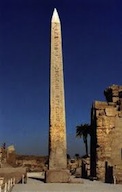
Karnak
The temples, the monuments associated with them (notably the obelisks, so many of which have been displaced to modern western sites), the tombs (including those in the pyramids) and fragmentary remains are all that we have, aside from a modest harvest of texts in the form of papyrus scrolls and stone inscriptions, to study the ancient Egyptians. Naturally, then, we visit the temples and attend to all that we can learn from them, including their wall reliefs, their architectural plans, their other decorations, their locations, their interrelations. Unfortunately, most of the temples that still survive date from the Ptolemaic period. Accordingly, we must also make some effort to learn of the temples that have not survived.
Jason Thompson, A History of Egypt: From Earliest Times to the Present
Under the Romans, Oxyrhynchus [pop. 40,000] contained three temples to Zeus-Amun, Hera-Isis and Arargaris-Bethynnis, a large Serapeum, two temples to Isis, one to Osiris, four to Thoeris, plus cult centers for Demeter, Kore, the Dioscuroi, Dionysos, Hermes, Apollo, Agathos, Daimon, Neotera, Tyche, Jupiter Capitolinis and Mars, Thompson tells us in his recent sweeping history. “Egypt supplied the grain for Rome; income from its imperial estates; and its stone adorned many buildings.” “No fewer than three 1st century emperors — Caligula, Claudius and Nero — were directly descended from Marcus Antonius (through Octavia, not Cleopatra), so the Egyptian associations of their ancestor came readily to their minds.”
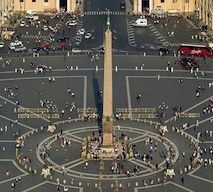
St. Peter's
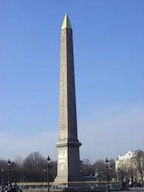
Place de la Concorde
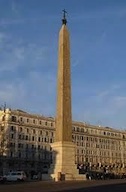
San Govanni in Laterano
“Rome, beginning with Augustus, was fascinated with Egyptian obelisks. Caligula constructed a special ship to transport an obelisk that weighed five hundred tons, and which now stands at the center of St. Peter’s Square. Over 300 years later, Constantinus had another erected in the Circus Maximus (later moved to the Church of San Giovanni in Laterano (Divine). Several more obelisks were transplanted from the banks of the Nile to the imperial city, or were custom-made in Italy, so that Rome has more Egyptian obelisks than Egypt does. Egyptian Roman decorative art can be viewed (see Divine again) in Hadrian’s Villa at Tivoli and in the Palestrina mosaic for Fortuna Primigenia [cp. Isis], at modern Praeneste.”
Robert G. Morkot, The Egyptians: An Introduction
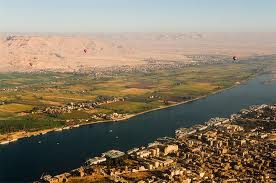
Luxor / Thebes / Waset
“Most people arriving in Egypt before the advent of air travel came by sea or across the Sinai land bridge. They therefore arrived at one of the mouths of the Nile or, later, at Alexandria, before traveling upstream. The Delta and its cities were the first places encountered.”
“Viewing Egypt this way helps us appreciate that despite its many surviving monuments, Thebes was actually quite remote from the ancient centers of population and production. We must rethink Thebes as a ‘capital’ and question our emphasis upon its monuments.”
“Thebes was no better placed to serve as capital than any other towns in Upper Egypt. Koptos and Edfu had better connections with the Eastern Desert routes and the Red Sea. Tjeny was better placed for access to the western Oases, Abydos had religious significance.”
“Ancient Egypt had no myth recording the origin of the population or the foundation of the state dependent upon one ‘people’ as, for example. Rome and the Israelites had. Egyptian origins of both the people and the state are attributed to the creation of the gods.”
“At Thebes, for which we have most archaeological and textual evidence, there were processions at the end of every ten-day week, when the statue of Amun was taken to Djeme (Medinu Habu) and back to Luxor (or Karnak). Amun sailed from Karnak across the river.”
“There he stayed overnight at the temples of Deir el-Bahri. The people of Thebes visited their family tomb chapels to celebrate rites of rebirth. At Opet the statues of Amun, Mut and Khonsu traveled from Karnak to the temple of Luxor to celebrate Amun’s marriage.”
Individual gods as cult figures (Hornung in conclusion)
“By becoming existent, the divine loses the absolute, exclusive unity of the beginning of things. But wherever one turns to the divine in worship, addresses it and tends it in the cult, it appears as a single, well-defined figure that can for the moment unite all divinity within itself.
“It does not share divinity with any other god. And the human being who encounters god becomes a single person who has no other beside him and embodies all humanity. This divine and human unity is, however, always relative and never excludes a fundamental plurality.”
Kent R. Weeks, ed. Valley of the Kings: The Tombs and Funerary Temples of Thebes West
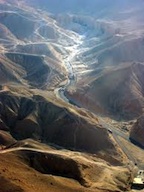
Valley of the Kings
The living temples of Egypt, like its gods and pharaohs, are too numerous to survey. Christian Leblanc, former director of the French Archaeological Mission in Thebes, has contributed to the Weeks anthology an interesting piece on “The Temple of Rameses II,” christened “The Ramesseum” by Champollion, the decoder of the hieroglyphs.
An immense plot on the west bank of the Nile opposite modern Luxor, “during Rameses II’s lifetime, the temple served as a large religious and economic center. Offerings were made daily to Amen-Ra and the other divinities who resided in the ‘Castle of Usermaatra Setepenra that Joins Thebes-City, in the Domain of Amen,’ as the Egyptians called it.
“Especially noteworthy in the vast pantheon venerated at the sanctuary were Mut and Khonsu, Ra-Horakhte, Isis, Ptah, Sekhmet, Osiris, Hathor, Amun, as well as King Rameses, ‘the great god,’ and Ahmose-Nefertari, the mother of Amenhotep I, who was deified after her death and venerated at least up to the 21st dynasty.” “Originally the Ramesseum also included secondary chapels, crypts, a chthonian as well as a solar complex and a library. To the south of the first courtyard are located the remains of the royal palace that was used during certain important Theban liturgies.” The temple today lies in almost total ruin.
“Built just after Rameses II’s coronation, the Ramesseum is a ‘Temple of Millions of Years,’ the first thought to have been built at the end of the Middle Kingdom. It is not strictly a funerary temple, but more of a memorial glorifying the monarchy in the person of the king. The important events of his reign, such as his victories, are masterfully depicted on the remaining walls and perpetuate his peaceful symbiosis with Maat, the entity that incarnates harmony, or rather universal cosmic balance. The pharaoh who reached the divine sphere here, received a cult through the petrified hypostases in the form of statues and colossi.”
T. G. Henry James, Tutankhamun: The Eternal Splendor of the Boy Pharaoh
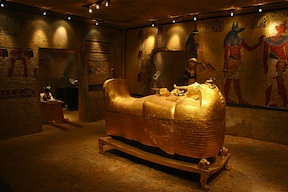
Tutankhamun's gold coffin
The Innermost Coffin. “The excavators were much puzzled by the great weight of the coffins, once removed from the sarcophagus. The mystery was solved when the lid of the middle coffin was raised and they found a third coffin made of solid gold. After the removal of its contents and cleaning, it was found to weigh 110.4 kg. It is quite the most impressive coffin ever found, but apart from its bullion value it is an outstanding piece of craftsmanship; the head is particularly well done, its features distinctly those of the young king. Again he is shown with the uraeus and vulture on his brow, and holding the crook and flail, symbols of royalty. Around the neck are necklaces of disc beads of gold and colored glass.
“When the coffin was placed in the middle coffin, large quantities of bituminous resin were poured over it, which in time fixed it firmly in place. It took Carter and his assistants much time to soften and chip away this material, in order to separate the two coffins. The hot bitumen had damaged some of the inlays and caused deterioration in some elements of decoration, including the calcite whites of the eyes. The decoration of the main body of the coffin is again rishi-work, but here in the form of chasing rather than inlay. Splendid figures of the cobra Wadjet and the vulture Nekhbet with outstretched protective wings are shown on the chest, and farther down on the side of the legs are delicate reliefs.
“These represent Isis and Nephthys, traditional guardians and mourners of the dead, also with protecting wings. On the foot of the coffin is another figure of the goddess Isis with outstretched wings, beautifully designed to fit the available space. She is shown kneeling on the sign for ‘gold,’ and she is described as ‘Great Isis, mother of the god.’”
Valley of the Kings: The Tombs and the Funerary Temples of Thebes West
The ancient Egyptian Progress toward The Next World as Fashion Show (MM)
“The Tombs of the Queens. In their ‘eternal residences,’ queens and princesses pose in attitudes that vary only slightly. They are most frequently standing, sometimes seated before a table of offerings or, even more rarely, kneeling. The wives or daughters of the king are frequently dressed in a long, flowing robe of fine pleated white material, tied at the waist with a belt that falls forward in two or four embossed sections. In most cases, they wear the traditional vulture skin on their heads, over a simple cap or one adorned with cobras (uraei).
“Over this headdress there are sometimes two long straight feathers, at the bottom of which is the disc of the sun. These feathers, as some examples show, could be replaced by lotus fruits whose flexible stalks spring out of the cap. In the tomb of Isis we see another variant of this theme in at least two places. The queen’s headdress is surmounted by a kind of diadem made up of rearing and circling snakes. Two other designs show the sovereign with a modius on which there are circling cobras, rearing snakes and a vulture wearing an atef-crown.
“Pectorals or necklaces with several rows of beads, bracelets, armlets are the essential items in the jewelry shown in the paintings of queens and princesses in these tombs. Sometimes they also wear earrings. Most models take the form of small floral motifs, rings, studs, rosettes or, most frequently, snakes in the tombs of Nefertari, Meryetamun and Nebetauy. In the tomb of Nefertari, on the northeast wall of the western side room of the sarcophagus room, the queen appears in the form of Osiris. This is the only confirmed example of the avatar.
“Standing, the sovereign is wound in a shroud from which there emerges only the head, wearing a classical three-part wig covered in the vulture skin and cap. By way of finery, the wife of Rameses II wears a pectoral with a series of bands falling to the level of her breasts. Also in this tomb, on the southwest wall of the antechamber, is the only image of the queen in the form of a bird spirit. Perched on a niche that is a simplified reproduction of the tomb, the bird is shown with a human head, that of Nefertari, wearing the vulture skin and cap.
“Hatshepsut and Tiy are shown in the form of sphinxes, the notion not abandoned with the queens of the Ramessid period. This is confirmed by an image of Tiy on the northwest wall of an annex chamber of her tomb. The great wife of Seti I here takes the form of a lion with human head, wearing the vulture skin surmounted by a cap and two long, straight feathers. The sovereign offers balsam to a god whose face has disappeared. In the tomb of Bentanat, two sphinxes adorn the opening of the door that gives access to an antechamber.
“Lying in a chapel with a door, the oldest daughter of Rameses II is also shown with a human head, but this time she wears a wig in long sections that partly conceal the vulture skin on which is laid a cap without feathers. These original paintings of Bentanat are placed on a high frieze made up of two djed-pillars and a knot of Isis. . . . At several places in the tomb of Tiy the great wife of the king takes on the features of a girl, while at certain other places she is shown as a woman in a flowing, pleated robe and fine sandals with up-turned toes.
“The princess-queen wears a short wig with a cobra on the front. The typical plait of childhood falls to the longer side, at the back. In two cases the headdress is dominated by a cap with two tall feathers, in front of which is represented the solar disc. The theme of the queen in the company of her daughter is exceptional, as it only appears in one tomb of the necropolis, that of Bentanat. It appears on the east wall of the sarcophagus room. Her mother stands behind her in a posture of adoration, this ‘daughter of the king engendered by him.’
“She is clearly distinguished from Bentanat by her youthful appearance, the youthful curl falling over her shoulder, and a lotus flower whose umbel falls slightly to her forehead. She wears a ring in her ear that partly conceals the wig. Unique in such a burial situation, the painting also confirms that the marriage of the king with his daughter, Bentanat, the oldest daughter of Rameses II and Isis-Nofret, who later became a great royal wife, really was consummated. The anonymous princess in the tomb is clearly the result of a special union.
“Thus the idea that such sacred marriages between father and daughter were merely symbolic has now been abandoned. Another view of this young girl, before the goddess Nephthys, shows her with a straight plait that falls to one side of her face.”